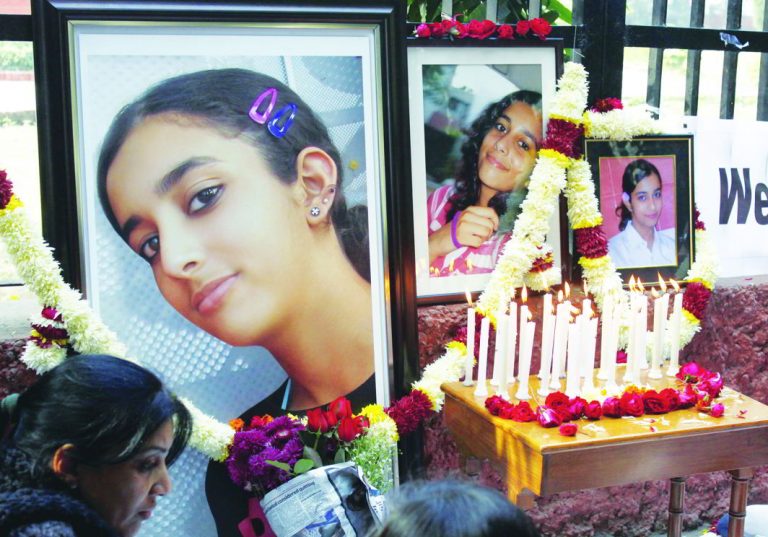
The Allahabad High Court’s acquittal of Nupur and Rajesh Talwar, the parents of murdered teenager Aarushi, exposes how investigating agencies and lower courts can subvert the cause of justice
By Sujit Bhar
The parents of Aarushi Talwar were acquitted via the provision of the benefit of doubt route by an Allahabad High Court bench of Justices Arvind Kumar Mishra and Bala Krishna Narayana on October 12. The bench found “insufficient evidence” for the life sentence on the two to stick. The parents are at present lodged in Ghaziabad’s Dasna jail.
The issue is that they aren’t really free, yet. The 273-page judgment of the bench initially had a mistake in one of the names of the Talwars and this became evident to the lawyers when they got the certified copies. The order went back to the court to be corrected, so failed to reach the trial court of the CBI whose life sentence order had been quashed. The parents have actually been given bail for six months, for which they have to pay bond value. If the CBI does not move the Supreme Court in six months from now, the bails will lapse and the acquittal order will be final. The Talwars are likely to walk out of jail on October 16.
Days before her 14th birthday, Aarushi’s life was snuffed out, her throat slit with surgical precision, her head bludgeoned. The lifeless body of the only child of successful dentists Rajesh and Nupur Talwar of Flat No. L-32 in Jal Vayu Vihar in Noida was found in her bedroom on the morning of May 16, 2008. Forensic experts have said that she was killed the night before.
Investigative agencies failed miserably, says former top cop
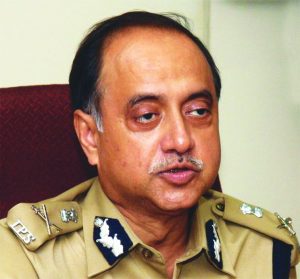 Former Delhi Police Commissioner Neeraj Kumar has said in his column: “It is a classic whodunit, where the true prowess of investigating agencies and their scientific support systems was tested, and where, I dare say, they failed miserably. As a proud police officer, I say this with a heavy heart.
Former Delhi Police Commissioner Neeraj Kumar has said in his column: “It is a classic whodunit, where the true prowess of investigating agencies and their scientific support systems was tested, and where, I dare say, they failed miserably. As a proud police officer, I say this with a heavy heart.
“It is one of those cases in whose investigation and follow-up, everything went wrong from the word go. To begin with, the scene of crime was trampled over by family members and neighbours before the police arrived at the spot, resulting in the bulk of the evidence being destroyed. The crime scene investigation by the local police was sloppy and unprofessional, to say the least. The Noida cops even missed out on finding the other corpus delicti of Talwars’ servant Hemraj on the terrace, leave alone other evidence from the spot.”
While the murder itself left the nation shocked, what followed was astounding. The immediate suspect was Hemraj Banjade, the family’s 45-year-old domestic help. But when Hemraj’s body too was found later on the terrace of the same flat, lying in a pool of blood, the mystery deepened.
There were other suspects, and the report by a CBI team led by joint director Arun Kumar (probe done between June 2008 and April 2009) had indicated that Dr Rajesh Talwar’s compounders, Krishna (Thadarai) and Raj Kumar, along with Vijay Mandal (a domestic help of the Talwars’ neighbour) had forced themselves into Aarushi’s room while drunk and gagged her. One of them hit her on the head with a blunt object. Kumar said in his report that they “tried to abuse her. This led to an altercation between them.” (The pathology report later said that she was neither sexually assaulted nor raped.) The report also says: “Fearing that the noise would wake the Talwars (adjacent room), they went to the terrace where Raj Kumar and Krishna had a scuffle with Hemraj and killed him.”
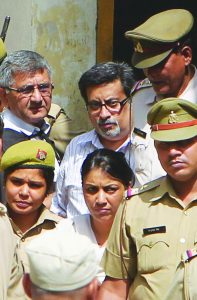
This did not stick, even after narco tests that are, anyway, inadmissible in court. The suspicion fell on the parents themselves. That was when they were charged with murdering their only child —the allegation was one of honour killing—and sent to jail. Even the Supreme Court found little to intervene—the court said in its observations that it was not possible to go into the evidence at that stage—and sent the case back to the magistrate of the special trial court for the trial to continue. The trial court rejected a closure suggestion by the CBI and the life sentence was imposed in November 2013. The allegation was of murder, of destruction of evidence with common intent and additionally, on Rajesh, of giving a false statement to the police.
This was the verdict that the Allahabad High Court quashed on October 12, freeing the Talwars. Justice Ashok Kumar Ganguly, who was one of the Supreme Court judges (the other was Justice JS Khehar) to have returned the case to the magistrate for the trial to continue, mentioned to India Legal the key point emanating from this current judgment. “In the end we still do not know who the murderer was,” he said.
He further said: “I remember the case. There were four people in the entire issue, the Talwar parents, their daughter Aarushi and the domestic help Hemraj. Two of them died, leaving two alive.” His inference, of course, was that there possibly was less scope for manoeuvring in this case than has been made out. He refused to comment on the judgment per se, saying: “That would not be right.”
And at that point, even if the court did not go into the details, by reading the evidence, the judges of the Supreme Court had observed in their order:
“In the case diary there is no such evidence from which it may appear that some person had made forcible entry and there is no evidence regarding involvement of the servants. In the night of the incident, Internet was switched on and off in the house in regard to which this evidence is available in the case diary that it was switched on or off by some person. Private parts of deceased Aarushi were cleaned and deceased Hemraj was dragged in injured condition from the flat of Dr Rajesh Talwar up to the terrace and the terrace was locked. Prior to 15.5.2008, terrace was not locked.”
What the Judgment Says
Justice AK Mishra of Allahabad HC was scathing in his remarks:
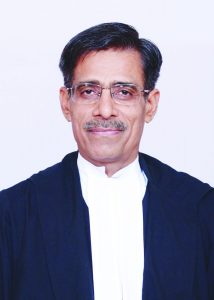 “Some reflection need be made upon the style and approach of the trial Judge who recorded conviction and awarded sentence against the appellants. The learned trial Judge has prejudged things in his own fashion, drawn conclusion by embarking on erroneous analogy conjecturing to the brim on apparent facts telling a different story propelled by vitriolic reasoning. In all criminal trials, analogies must be drawn and confined within the domain and realm of the evidence, facts and circumstances on record and any analogy which brings facts, circumstances and evidence so placed in certain domain outside the periphery of that domain then that would be a case of certain aberration deviating from the main path.
“Some reflection need be made upon the style and approach of the trial Judge who recorded conviction and awarded sentence against the appellants. The learned trial Judge has prejudged things in his own fashion, drawn conclusion by embarking on erroneous analogy conjecturing to the brim on apparent facts telling a different story propelled by vitriolic reasoning. In all criminal trials, analogies must be drawn and confined within the domain and realm of the evidence, facts and circumstances on record and any analogy which brings facts, circumstances and evidence so placed in certain domain outside the periphery of that domain then that would be a case of certain aberration deviating from the main path.
“That way, the learned trial Judge has aberrated and by dint of fallacious analogy and reasoning has surprisingly assumed fictional animation of the incident as to what actually took place inside and outside the Flat L 32 Jalvayu Vihar, and in what manner he has tried to give live and colourful description of the incident in question and the whole genesis of the offence was grounded on fact that both the deceased Hemraj and Aarushi were seen by Dr. Rajesh Talwar in flagrante and thereafter like a film Director, the trial Judge has tried to thrust coherence amongst facts inalienably scattered here and there but not giving any coherence to the idea as to what in fact happened.
“It can by no means be denied that the trial Judge, perhaps out of extra zeal and enthusiasm and on the basis of self perception adopted partial and parochial approach in giving vent to his own emotional belief and conviction and thus tried to give concrete shape to his own imagination stripped of just evaluation of evidence and facts of this case.”
These were prima facie the issues being dealt with. In the current judgment, the Allahabad High Court bench was scathing in its remarks on the trial judge. Justice Arvind Kumar Mishra commented: “The learned trial Judge has prejudged things in his own fashion, drawn conclusion by embarking on erroneous analogy conjecturing to the brim on apparent facts telling a different story propelled by vitriolic reasoning…” Justice Mishra went on to compare the trial judge to a film director. He said: “…like a film director, the trial judge has tried to thrust coherence amongst facts inalienably scattered here and there but not giving any coherence to the idea as to what in fact happened.”
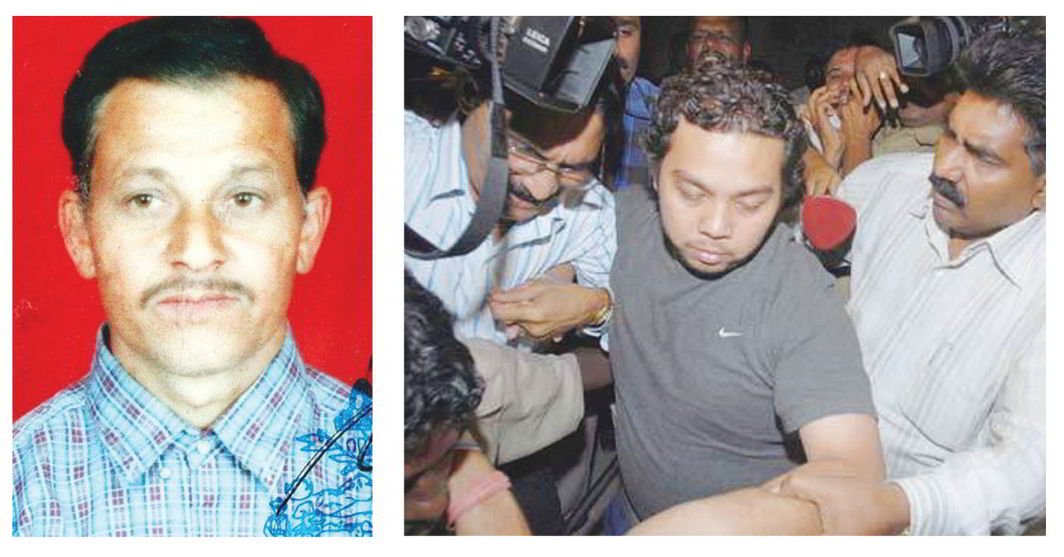
The judge also listed some norms regarding judgments in similar cases.
1) The parochial and narrow approach to the facts and evidence should be avoided and evidence of a particular case has to be read and construed on its face value in line with the statutory requirement.
(2) The passionate and rash reasoning should not be the guiding factor while scrutinizing evidence, facts and circumstances of a criminal case.
(3) The self-perception and realm should not be reflected on analogy of the facts and evidence on record.
(4) The judgment should not be based on self-created postulates.
(5) The imagination should not be given a concrete form and transparency of approach must be reflected in the judgment.
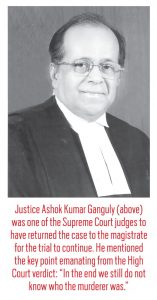 The issues have been dealt with a strong hand by the High Court. Its decision was based on the fact that the CBI had failed to prove beyond reasonable doubt the guilt of the Talwars in a case that has for long intrigued the entire nation and has been the source of a book and even a Bollywood movie.
The issues have been dealt with a strong hand by the High Court. Its decision was based on the fact that the CBI had failed to prove beyond reasonable doubt the guilt of the Talwars in a case that has for long intrigued the entire nation and has been the source of a book and even a Bollywood movie.
The entire bungling of the case was at the CBI-level inquiry. Arun Kumar’s team exonerated the parents and blamed the servants, but when the agency’s Deputy Director Nilabh Kishore took over in May 2009, the second team said that Rajesh Talwar was the culprit. This team said that the three accused domestic helps—Krishna, Kumar and Mandal—were not even present at the Talwars’ house at that time. Incidentally, all the findings were arrived at merely through circumstantial evidence.
Arguments for and against the Talwars have been keenly followed by the public, with different sections of the media also putting forth their views. This was, possibly, the most awaited non-political verdict of the last decade.
The court accepted the argument of the Talwars’ counsel that the case had been built entirely around circumstantial evidence which failed to conclusively prove the Talwars as the perpetrators of the crime.
In the end, as Justice Ganguly said, nobody murdered Aarushi. At least it has not been proved in nine long years of intense investigation.
Read Also:-
Aarushi murder case saw some of the worst reportage from Indian media
For the Talwars, this acquittal is the best of a bad situation
Aarushi murder case: Allahabad HC acquits Talwars via benefit of doubt

